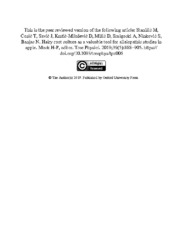Приказ основних података о документу
Hairy root culture as a valuable tool for allelopathic studies in apple
| dc.creator | Stanišić, Mariana | |
| dc.creator | Ćosić, Tatjana | |
| dc.creator | Savić, Jelena | |
| dc.creator | Krstić Milošević, Dijana | |
| dc.creator | Mišić, Danijela | |
| dc.creator | Smigocki, Ann | |
| dc.creator | Ninković, Slavica | |
| dc.creator | Banjac, Nevena | |
| dc.date.accessioned | 2020-07-21T10:49:37Z | |
| dc.date.available | 2020-02-28 | |
| dc.date.available | 2020-02-28 | |
| dc.date.issued | 2019 | |
| dc.identifier.issn | 1758-4469 | |
| dc.identifier.uri | https://radar.ibiss.bg.ac.rs/handle/123456789/3791 | |
| dc.description.abstract | Allelopathic plants exploit their chemical ‘weapons’ to prevail over the competition, suppress neighboring plants and consequently use the available resources more efficiently. However, the investigation of plant allelopathic interactions in rhizosphere is difficult to perform because of its high complexity due to interactions of biotic and abiotic factors. Thus, autonomous, aseptic root cultures of apple (Malus × domestica Borkh.) could facilitate allelopathic studies. We report on the successful genetic transformation of apple cultivars Melrose, Golden Delicious, Cadel and Gloster using ˇ Agrobacterium rhizogenes (Riker et al. 1930) Conn 1942 strain 15834 and for the first time the establishment of apple autonomous and permanent in vitro hairy root cultures that could be used as a new tool for apple allelopathic assays. Molecular characterization of transgenic hairy root lines was conducted to elucidate the possible relationship between expression of T-DNA genes and root growth characteristics that include branching. Similar content of phenolic acids (chlorogenic, caffeic, syringic, p-coumaric and ferulic), glycosilated flavonoids (rutin, quercitrin, isoquercitrin, kaempferol-3-glucoside) and flavonoid aglycones (quercetin and naringenin), and dihydrochalcone phloridzin, was detected in untransformed and transgenic apple root tissue by ultra high-performance liquid chromatography with mass spectrometry (UHPLC/(+/–)HESI–MS/MS) analyses, confirming that genetic transformation did not disturb secondary metabolite production in apple. Chlorogenic and caffeic acids and dihydrochalcones phloridzin and phloretin were detected as putative allelochemicals exuded into the growth medium in which transgenic roots were maintained for 4 weeks. Apple hairy root exudates significantly affected shoot and root development and growth of test plant Arabidopsis thaliana (L.) Heynh. seedlings after 5 or 10 days of treatment. Additionally, core cell-cycle genes CDKA1;1, CDKB2;1, CYCA3;1 and CYCB2;4 were down regulated in Arabidopsis shoots suggesting, in part, their role in inhibition of shoot growth. The present work highlighted an autonomous and permanent in vitro hairy root culture system as a valuable tool for studying allelopathic potential of apple, offering new perspective for allelopathy background elucidation in this important fruit species. | en |
| dc.language.iso | en | sr |
| dc.publisher | Oxford:Oxford University Press | sr |
| dc.relation | info:eu-repo/grantAgreement/MESTD/Basic Research (BR or ON)/173015/RS// | sr |
| dc.rights | embargoedAccess | sr |
| dc.source | Tree Physiology | sr |
| dc.subject | Agrobacterium rhizogenes | sr |
| dc.subject | allelopathy | sr |
| dc.subject | apple hairy root exudate | sr |
| dc.subject | Arabidopsis seedlings growth retardation | sr |
| dc.subject | in vitro culture | sr |
| dc.subject | polyphenols | sr |
| dc.title | Hairy root culture as a valuable tool for allelopathic studies in apple | en |
| dc.type | article | sr |
| dc.rights.license | ARR | sr |
| dcterms.abstract | Крстић-Милошевић, Дијана; Бањац, Невена; Нинковић, Славица; Смигоцки, Aнн; Савић, Јелена; Ћосић, Татјана; Станишић, Мариана; Мишић, Данијела; | |
| dc.rights.holder | © The Author(s) 2019. Published by Oxford University Press. | sr |
| dc.citation.issue | 5 | |
| dc.citation.volume | 39 | |
| dc.description.note | This is the peer reviewed version of the following article: Stanišić M, Ćosić T, Savić J, Krstić-Milošević D, Mišić D, Smigocki A, Ninković S, Banjac N. Hairy root culture as a valuable tool for allelopathic studies in apple. Mock H-P, editor. Tree Physiol. 2019;39(5):888–905. [https://doi.org/10.1093/treephys/tpz006] | |
| dc.description.note | Related to: [https://radar.ibiss.bg.ac.rs/handle/123456789/3792] | |
| dc.identifier.doi | doi:10.1093/treephys/tpz006 | |
| dc.identifier.pmid | 30811532 | |
| dc.citation.apa | Stanišić, M., Ćosić, T., Savić, J., Krstić-Milošević, D., Mišić, D., Smigocki, A., et al. (2019). Hairy root culture as a valuable tool for allelopathic studies in apple. Tree Physiology, 39(5), 888–905. | |
| dc.citation.vancouver | Stanišić M, Ćosić T, Savić J, Krstić-Milošević D, Mišić D, Smigocki A, Ninković S, Banjac N. Hairy root culture as a valuable tool for allelopathic studies in apple. Mock H-P, editor. Tree Physiol. 2019;39(5):888–905. | |
| dc.citation.spage | 888 | |
| dc.citation.epage | 905 | |
| dc.type.version | acceptedVersion | sr |
| dc.identifier.fulltext | https://radar.ibiss.bg.ac.rs/bitstream/id/6570/TreePhysiol_2020.pdf | |
| dc.citation.rank | aM21 |

